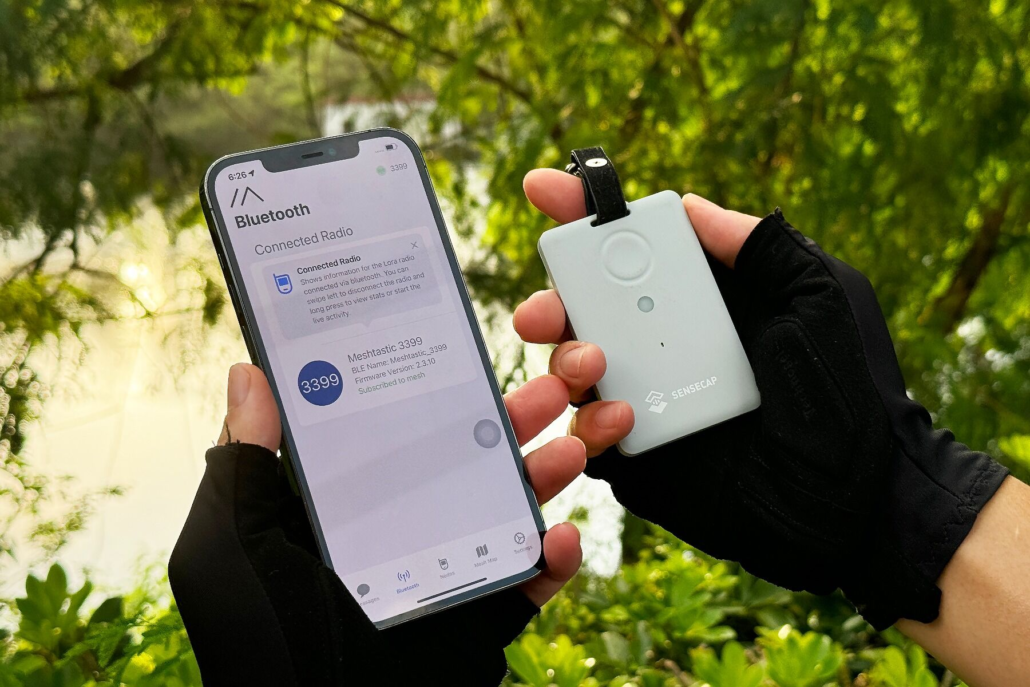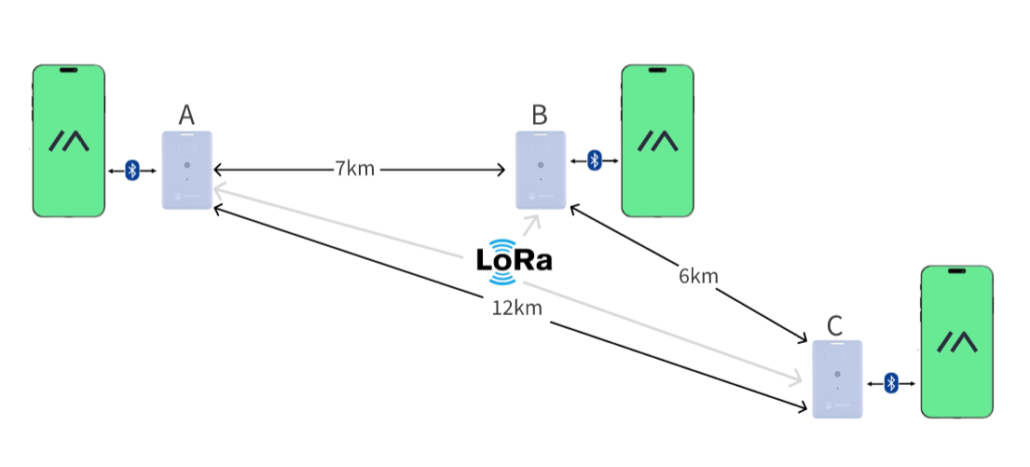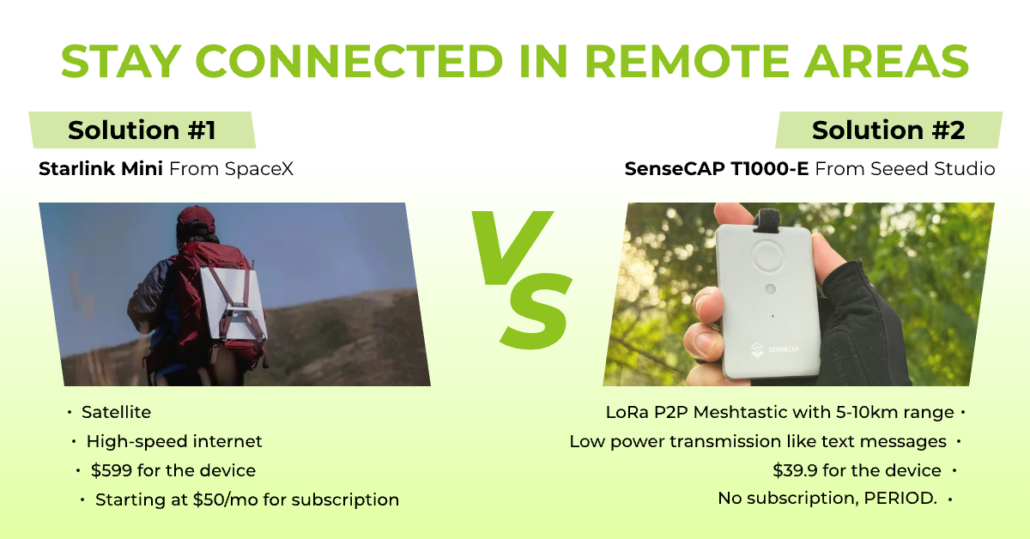How to Stay Connected in Remote Areas Without 5G: Starlink Mini vs Seeed T1000-E
When you’re mountain climbing, out at sea, or in the forest—how do you stay connected in those remote places with no signal? Recently, SpaceX launched their new satellite internet system, Starlink Mini, allowing you to enjoy high-speed internet even in remote areas. The Starlink Mini costs $599, and you can choose between a $150 or $50 roaming plan.
Is there a more affordable option? Certainly! That’s what I want to share with you today, the other worth considering remote connectivity solution besides Starlink Mini, SenseCAP T1000-E, a more affordable solution based on Meshtastic when you don’t require high-speed internet.
What is Meshtastic?
For those unfamiliar with Meshtastic, it is an open-source mesh communication protocol based on LoRa, which enables the creation of a low-power, long-range, off-grid communication network.
SenseCAP T1000-E: A More Affordable Option
SenseCAP T1000-E from Seeed Studio, a nifty card-size Meshtastic device, working seamlessly with the Meshtastic LoRa mesh network. It embeds Semtech’s LR1110, Nordic’s nRF52840, and Mediatek’s AG3335 GPS module.

SenseCAP T1000-E has the following main features:
1. Direct point-to-point communication with a range of 5-10 km using LoRa technology.
2. Any T1000-E or Meshtastic device can act as a repeater to relay messages, extending the communication range. So even if the distance between A and B exceeds the communication range, the information can be successfully relayed and transmitted as long as there is a repeater in between.
3. Encrypted communication ensures only the target node can view the messages.
These features make this technology ideal for outdoor scenarios. For example, when three people (A, B, C) go hiking, each carrying a T1000-E paired with their phone via Bluetooth, they can communicate through the Meshtastic network without relying on external networks like 4G/5G.
Message on phone A is sent to T1000-E node A via Bluetooth, then transmitted to T1000-E node B via LoRa, which decodes the message and sends it to phone B via Bluetooth. If they are out of range like A and C, the message can be forwarded through another node B, creating a mesh network. This way, C can still receive the message sent from A, as B acts as a repeater to broadcast the message. Additionally, they can group chat and view each other’s locations in real-time while hiking.

For those already familiar with LoRa, you may heard of LoRaWAN, one of the main differences between Meshtastic and LoRaWAN is: unlike previous LoRaWAN devices that required gateways for communication between different nodes, the T1000-E leverages Meshtastic’s P2P features and does not require any gateways. This allows nodes to establish a free mesh network and communicate even in the absence of existing or reliable communication infrastructure.
P.S. We also have a Wio Tracker 1110 Dev Kit for Meshtastic that offers a plug-and-play user-friendly solution to build a Meshtastic device. With native Arduino compatibility, it’s perfect for developers to custom-build reliable wireless Meshtastic LoRa Mesh networks for remote adventures like asset tracking, outdoor activities, and more. You can learn more about it here.
Comparison between Starlink Mini and SenseCAPT1000-E
We made a rough comparison below, just to give everyone a straightforward look at the differences between the two communication methods.

How to Choose the Best Fit for You?
Solution #1: Starlink Mini
- Surf Internet Without Bounderies: Delivers high-speed internet access, necessitating an ongoing monthly subscription fees.
- Usage Scenarios: Suitable for you who require constant online presence and high-speed Internet applications even in remote areas.
Solution #2: SenseCAP T1000-E
- Free Decentralized and Encrypted Messaging Network: No subscription fee and no router required to build your own mesh network, with encrypted communication ensuring secure data transmission even if relayed.
- Usage Scenarios: Suitable for those wanting to stay connected with loved ones without requiring high-speed internet, the more affordable, portable communication device is ideal for you to use in remote areas.
Cost Comparision: The Device’s Cost and the Subscription Fee
- Starlink Mini: It’ll cost you $599 and you can get the Mini with a $150 or a $50 roaming plan.
- SenseCAP T1000-E: It’ll cost you $39.9 and there’s no subscription fee with the FREE LoRa Mesh Network.
Comparison of Portability: A Concern for Some Users
- Starlink Mini: Measures 259 x 259 x 38.5 mm and weighs 1.1 kg, which is relatively a little heavier.
- SenseCAP T1000-E: Measures 85 x 55 x 6.5 mm and weighs only 32 g, which can be effortlessly fitting in your pocket or attaching to your assets.
SenseCAP T1000-E is Now Available
SenseCAP T1000-E is now available for pre-order at $39.9, with an early bird discount of 10% off before August 23, 2024. We support global shipping, so you can start your connection in remote areas with SenseCAP T1000-E wherever you are now.
By the way, more and more business scenarios are starting to use Meshtastic solutions. If there is interest in collaboration, such as white-label customization of our SenseCAP T1000-E, please feel free to contact us at iot@seeed.cc.
An Interesting Demo: Biking With T1000-E
Take a look at how our team uses the SenseCAP T1000-E while biking:
To Learn More
Here is a detailed product introduction video if you’d like to learn more:
By using multiple devices, you can extend the range and create a robust communication network that ensures you stay connected with your team.
Exactly!!